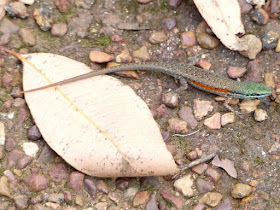This posting
continues a theme of exploring 'empty' (or at best unhelpful) but laudatory names of organisms. Why? Well, partly just for fun, and partly to meet some plants and animals which we may not otherwise have done. Interestingly mammals for the most part seem not to have inspired such names. Last time we met quite a few animals carrying some of the names we'll be looking at today and next time, but those also used the name as an English name, so we won't revisit them.
For translations of these words I'm relying on my friend and colleague Jeannie Gray, co-author with me of Australian Bird Names, of which we're currently working on a new edition. I'm using her work in that book for nearly all of these names.
superbus/a - superb
Apart from the ones we met last week, I don't have many with this name.
 |
Flame Lily, Fire Lily, Glory Lily etc, Gloriosa superba Family Colchicaceae, near Masindi, Uganda
- and isn't 'superb glorious plant' an over-the-top name?!
One can understand its describer's passion though, it really is stunning, though every part of it is highly toxic. |
gloriosa - superb
And of course the previous plant could have been included here too. What we do have here is the Australian Capital Territory's official flower (and for more on that somewhat murky story, see
here).
 |
| Royal Bluebells Wahlenbergia gloriosa Family Campanulaceae, Namadgi National Park, above Canberra. |
magnificus - magnificent (really Jeannie, how hard is this?!)
 |
Large Pansy Orchid Diuris magnifica, Perth, Western Australia.
And I do have to say that the somewhat anaemic English name is a bit sad compared with magnifica!
|
Most of the following names however aren't as bombastic as those; they're gentler, but no more helpful!
elegans - elegant, fine, handsome, tasteful
 |
Velvet Parachute Marasmius (Collybia) elegans, Tidbinbilla NR, near Canberra.
And I'm pretty sure this will be the only fungus to make an appearance here.
|
 |
Crimson Rosella Platycercus elegans, Canberra, where it's a common garden bird.
The rosellas inspired a few such names, as you'll see. |
 |
| Red-backed Fairywren Malurus elegans near Injune, Queensland. |
 |
Ring-tailed Vontsira Galidia elegans, Amber Mountain, Madagascar.
Often misleadingly called Ring-tailed Mongoose, this is actually one of the ancient Madagascan carnivores
and the Malagasy name Vonstsira is a much better choice. And it is elegant!
|
venustus - lovely, charming, graceful
 |
Northern Rosella Platycercus venustus, Darwin.
As mentioned previously, various taxonomists ran out of ideas when faced with these lovely parrots. |
eximius - uncommon, excellent, select
 |
Eastern Rosella Platycercus eximius, near our home in Duffy, Canberra.
Another taxonomist brought to near incoherence by these lovely birds! |
pulchellus - pretty (a diminutive of beautiful)
Quite a few of these, especially due to some botanists who'd seemingly run out of ideas.
 |
Correa pulchella Family Rutaceae, Coffins Bay NP, Eyre Peninsula, South Australia; a very pretty flower indeed,
widely cultivated but with only a limited distribution in coastal South Australia.
It lacks a generally accepted common name.
|
 |
Sphaerolobium pulchellum, Lesueur NP, Western Australia.
And spare some sympathy for anyone trying to keep coming up with new names for
the extraordinary cornucopia that WA wildflowers represent! See the next three species too.
|
 |
Prickly Moses Acacia pulchella, South Beekeepers NR, Western Australia.
This name is applied to several spiny acacias, Moses being a corruption of Mimosa. |
 |
Native Pomegranate Balaustion pulcherrimum Family Myrtaceae, near Hyden, Western Australia.
This one, according to its name, is very pretty!
|
 |
Teasel Banksia Banksia pulchella, Family Proteaceae, Esperance, Western Australia.
|
And a non-WA plant is also deemed to be Pretty!
 |
White Peppermint Eucalyptus pulchella, Wieltangta Forest, Tasmania.
|
And finally for today, some Pretty birds, from three continents.
 |
Green Pygmy Geese Nettapus pulchellus, Kakadu NP, Northern Territory.
Not really geese at all, but a part of a genus of three small ducks (two in Australia and nearby, and one in Africa). |
 |
Golden-naped Barbet Psilopogon pulcherrimus, Mount Kinabalu, Sabah.
A Borneo endemic, this one is also identified by its name as a very pretty bird.
|
 |
Chestnut-bellied Starling Lamprotornis pulcher, Waza NP, northern Cameroon.
Found across the full width of arid Africa just south of the Sahara.
|
And that's enough for today I think - I have enough material left for another posting on three more such flattering adjectives. If you're still enjoying this, hope to see you back for it next week.
NEXT POSTING THURSDAY 18 OCTOBER (by when I'll be back from Brazil)
(And
remember that you can get a reminder when the next post appears by
putting your email address in the Follow by Email box in the top right
of this screen.
And I'd love to receive your comments - it's easy and you don't need to sign in!)































